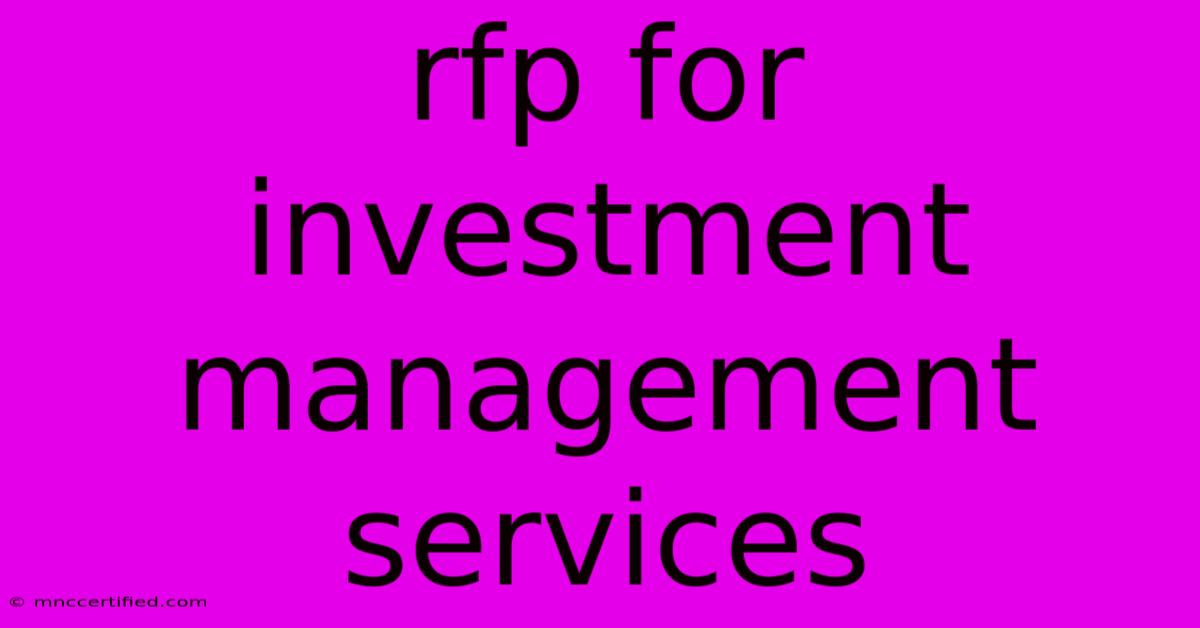Rfp For Investment Management Services

Table of Contents
Request for Proposal (RFP) for Investment Management Services: A Comprehensive Guide
Are you looking to enhance your investment portfolio through professional management? A Request for Proposal (RFP) is a critical step in this process, allowing you to attract qualified investment managers and choose the best fit for your needs. This guide will walk you through the essential elements of a strong RFP, helping you attract top-tier investment managers and make an informed decision.
What is an RFP for Investment Management Services?
An RFP for investment management services is a formal document outlining your investment goals, requirements, and expectations for potential investment managers. It serves as a blueprint for potential candidates, allowing them to understand your needs and propose a tailored investment strategy.
Why is an RFP Important?
A well-structured RFP offers several benefits:
- Clarity: It provides clear guidelines to potential managers, minimizing ambiguity and ensuring they understand your specific requirements.
- Fair Comparison: It facilitates a standardized evaluation process, allowing you to compare proposals based on similar criteria and make a well-informed decision.
- Competitive Bidding: An RFP fosters competition, potentially leading to better service offerings and more favorable terms for you.
- Professionalism: It reflects a structured and organized approach to investment management, signaling a commitment to due diligence and good governance.
Key Sections of an RFP for Investment Management Services
1. Introduction
- Purpose: Briefly describe your investment management needs and the purpose of the RFP.
- Background: Provide context about your organization, investment objectives, and the scope of the investment mandate.
2. Investment Objectives
- Investment Horizon: Define the expected duration of the investment management relationship.
- Risk Tolerance: Clearly articulate your acceptable level of risk, whether conservative, moderate, or aggressive.
- Return Expectations: Specify your target return on investment, including any benchmarks or performance goals.
- Investment Strategy: Detail your preferred investment style, including asset classes, market sectors, and investment philosophies.
3. Investment Management Requirements
- Investment Style: Outline your preferred approach to investment management, such as value investing, growth investing, or a specific investment strategy.
- Asset Allocation: Specify the desired allocation of assets across different classes, such as stocks, bonds, and real estate.
- Performance Reporting: Define the frequency and format for performance reporting, including key metrics and data visualization.
- Fees and Compensation: Describe your preferred fee structure and payment terms.
- Due Diligence: Indicate your requirements for due diligence, including background checks, regulatory compliance, and conflict of interest disclosure.
4. Proposal Submission Instructions
- Submission Deadline: Clearly state the deadline for proposal submission.
- Proposal Format: Specify the desired format and length of the proposal.
- Contact Information: Provide contact details for inquiries and proposal submission.
5. Evaluation Criteria
- Investment Performance: Outline how you will assess past performance records, including specific metrics and benchmarks.
- Team Expertise: Define your criteria for evaluating the team's experience, qualifications, and track record.
- Investment Process: Specify your requirements for the investment process, including research, analysis, and portfolio management.
- Communication and Reporting: Highlight your expectations for communication and reporting, including frequency, format, and content.
- Fee Structure: Explain how you will evaluate fee structures, including management fees, performance fees, and other charges.
6. Appendices
- Financial Statements: Include relevant financial data, such as balance sheets and income statements, to provide transparency and illustrate your investment capacity.
- Investment Guidelines: If applicable, provide specific investment guidelines or restrictions, including regulatory requirements or ethical considerations.
Tips for Crafting a Strong RFP
- Keep it concise: Use clear and concise language to avoid overwhelming potential candidates.
- Be specific: Avoid ambiguity in your requirements and expectations.
- Stay focused on your goals: Align the RFP content with your specific investment objectives and needs.
- Seek feedback: Get feedback from industry professionals or legal advisors to ensure your RFP is comprehensive and well-structured.
- Review and revise: Review and revise your RFP before sending it to potential investment managers.
Conclusion
A well-crafted RFP is essential for attracting qualified investment managers and finding the best partner for your investment journey. By following the guidelines outlined in this guide, you can create a compelling and effective RFP that sets the stage for a successful investment management partnership.

Thank you for visiting our website wich cover about Rfp For Investment Management Services. We hope the information provided has been useful to you. Feel free to contact us if you have any questions or need further assistance. See you next time and dont miss to bookmark.
Featured Posts
-
Heretic Movie Ending A Religious Critique
Nov 09, 2024
-
Is Ptosis Surgery Covered By Insurance
Nov 09, 2024
-
American Life Insurance Company Rating
Nov 09, 2024
-
Where To Watch 76ers Vs Lakers Game Live
Nov 09, 2024
-
Longtime Archers Actress June Spencer Dies
Nov 09, 2024